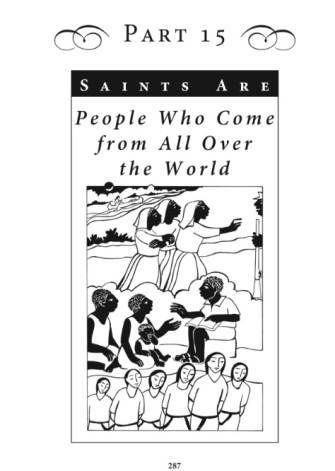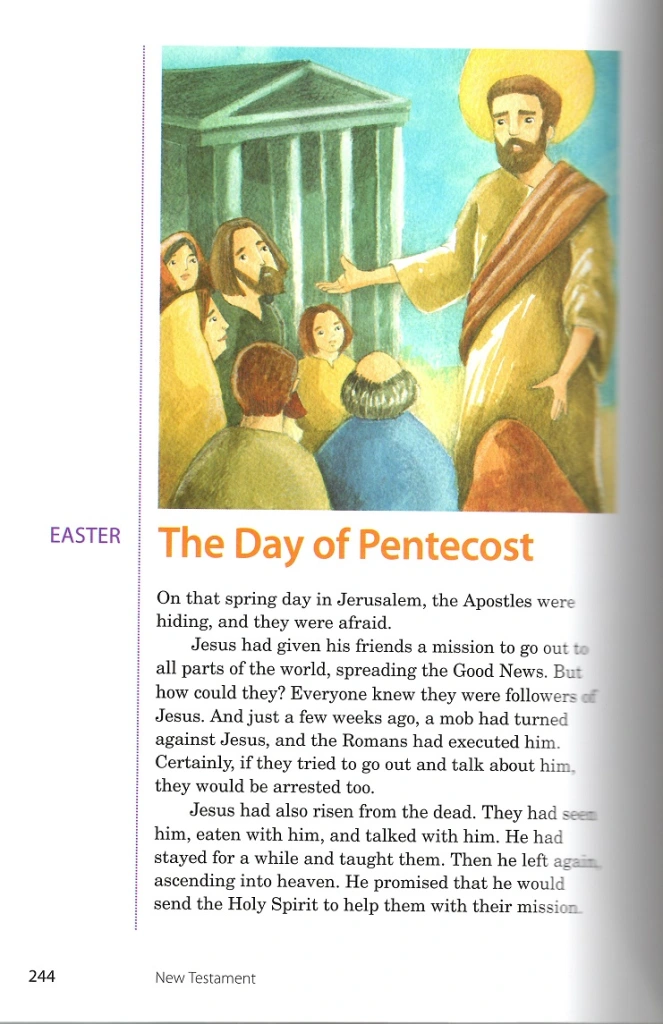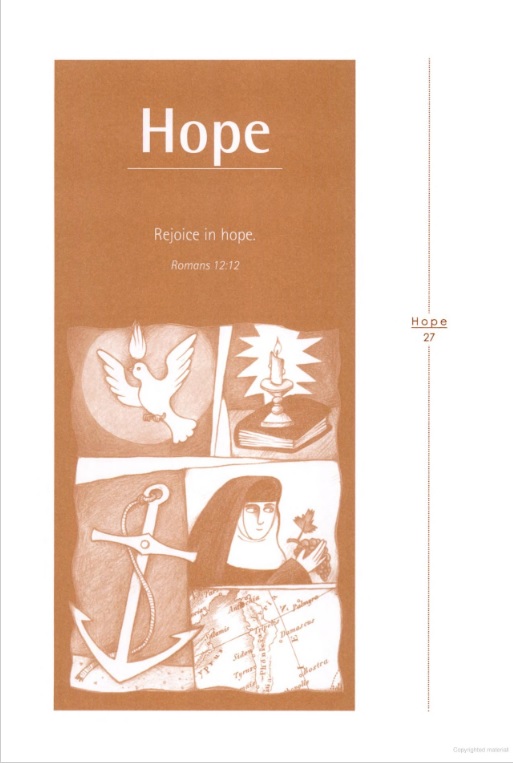Archive for the ‘Jesus’ Category
Monday, First Week of Advent
Posted in advent, Advent 2023, Amy Welborn, Amy Welborn's Books, history, Jesus, Life, Loyola Press, Michael Dubruiel, Religion, Spirituality, tagged Advent, Advent 2023, Amy Welborn, Amy Welborn's Books, Catholic, faith, Michael Dubruiel, religion on December 4, 2023|
St. Camillus de Lellis – July 18
Posted in Amy Welborn, Amy Welborn's Books, Bible, Catholic, Christian, Church, evangelization, Faith, First Communion Gifts, history, homeschooling, Jesus, Joseph Dubruiel, Loyola Kids Book of Saints, Loyola Press, Michael Dubruiel, prayer, Religion, Saints, tagged Amy Welborn, Amy Welborn's Books, Catholic, Catholicism, faith, France, history, Loyola Kids' Book of Saints, Loyola Press, Michael Dubruiel, religion, saints on July 18, 2023|
Celebrated in most of the rest of the world on July 14, but here in the US on July 18 – today!
A fascinating figure – mercenary, gambler…and then…

Painting Source and analysis
When you live in a landscape framed and defined by Scripture, the great Tradition and the lives of the saints, stories like those of St. Camillus de Lellis become no longer shocking. You see how God’s grace and power reaches into every corner of human life, into the corners of life of every kind of human person, and you can so very easily understand that you, too, have a place, that this Word is very near to you.
Living in the flesh – as Paul calls it – meaning, the worldly world, the material world of just things and people without reference to the One who loved us into existence and in Whose Image we are – you don’t get this. You look out and you see winners and losers, successes and failures, the talented and the schlubs, and you know who matters in that world and who doesn’t, who might as well just give up.
And maybe, you can’t help but suspect, you’re in that latter group.
And you shrug and watch that purposeful, meaningful world climb past, regretful and maybe even envious, and perhaps even hopeless and a little bit lonely. There they go, doing important things.
But that’s not real. That’s not The Real. Living in the Real World – God’s world – you know this. It’s so close to you, it’s what you breathe, that gift. Sure, you may struggle with some of it, wondering and wandering, but if your primary reference point is this crazy Word of God filled with the small and weak plucked out for greatness and the sinners starting over and the dead blinking in the light – and then day after day meeting his small, weak, sinful once-dead saints living those same stories again and again…
…life looks different, and you can live it in a different way.

From the Loyola Kids Book of Saints.
The Blessed Carmelite Martyrs of Compiègne
Posted in Amy Welborn, Amy Welborn's Books, Bible, Catholicism, Christian, Cross, evangelization, Faith, France, history, Jesus, Joseph Dubruiel, Loyola Kids Book of Saints, Loyola Press, Mass, Michael Dubruiel, Music, Religion, Saints, tagged Amy Welborn, Amy Welborn's Books, Catholic, Catholicism, faith, France, history, Loyola Kids book of saints, Loyola Press, Michael Dubruiel, Music, religion, saints on July 17, 2023|
Their story is told in my Loyola Kids Book of Saints.
Their story from the website of the Carmelites of Great Britain.
Now, here’s something interesting. There have been a couple of filmed versions of this story based in some sense on Bernanos’ play (and Le Fort’s book). Here’s a website comparing them – the 1960 version starring Jeanne Moreau (!) and a more sober 1984 version made for television. Below is a clip of the execution scene and it is quite effective and moving, showing mostly the crowd reactions and transitioning rather slowly to the sisters.
And then, of course, Poulenc’s opera. From First Things last week:
Sister Blanche bolts and hides out alone in the ransacked house of her father, who has just met his nobleman’s end on the guillotine. She resists Mother Marie’s entreaties to come join her sisters in their new gathering place, supposedly a safe one. In fact, it is the last stop before prison, where they are packed into one cell to await their execution. Courage means acknowledging one’s fear and rising above it, and in the final scene, the nuns singing hymns go bravely to their death one by one. The long legato lines of Salve Regina are punctuated but not interrupted by the thuds of the falling blade, until a solitary voice is left to intone the final lines of Veni Creator. Then that voice too is extinguished. The final nun to perish is Sister Blanche, who has arrived at the last minute to realize Sister Constance’s prophetic wish that the two friends die together.
The moral universe of Dialogues is notably opposed to that of the most famous French opera, Georges Bizet’s Carmen (1875)—whether Poulenc explicitly intended the contrast or not. Courage is the great theme of both, but where Poulenc presents the blessed fortitude of nuns willing to die for their faith, Bizet displays the hell-bent daring of characters who risk their lives—and some of whom lose their lives—in the service of the world, the flesh, and the devil: sexual heat, the crowd’s applause, or criminal greed. Here is an operatic world we are more familiar with: perfervid professions of love that are really something less than love, duty and honor and a nobler beloved all abandoned, and the ultimate murder of Carmen, who is as steadfast in her boldness in the face of death as she is volatile in her carnal desires.
Francis Poulenc felt the pull of the profane as well as the sacred, in his work as in his life. He wrote two other operas: Les Mamelles de Tirésias (Tiresias’s Teats, 1947), an opéra-bouffe or farce about the gender-fluid blind seer of Greek mythology, and La Voix Humaine (The Human Voice, 1959), the one-sided phone conversation of a woman cast off by her lover. In performances, the opera often ends with her suicide. Erotic misery was familiar territory to Poulenc, a gay man who was writing Dialogues while watching a lover die of cancer, and fearing he had cancer himself. His sexual temptations had long been a spiritual trial for him, for he was unable to renounce either his desire for men or his devotion to the Catholic Church. Dialogues des Carmélites presents, as eloquently as any modern work of art I know, the courage required to live and die in one’s faith, even though Poulenc knew himself incapable of such heroic will.
And then a clip of the Salve Regina from the Met’s production:
What’s the story?
Posted in Amy Welborn, Amy Welborn's Books, Bible, Bible Study, Catholic, Catholicism, Christian, evangelization, Faith, First Communion Gifts, history, Jesus, Joseph Dubruiel, Liturgy, Loyola Book of Seasons, Feasts and Celebrations, Loyola Kids Book of Signs and Symbols, Loyola Press, Mass, Michael Dubruiel, prayer, Religion, Writing, tagged Amy Welborn, Amy Welborn's Books, Catholic, Catholicism, faith, history, Loyola Kids Book of Seasons Feasts and Celebrations, Loyola Press, Michael Dubruiel, religion, saints, travel on July 17, 2023|
Of late, the first readings at daily Mass have been moving through Genesis, and on to Exodus this coming week. What do we hear? What’s their story? What’s our story?
God’s interaction with our lives is ongoing and surprising. As long as there is life on earth, there is no final moment, no perfection, no end to the journey, and it is wrong to attempt to characterize any one moment as the irreformable manifestation of God’s will.
We encounter God, we journey with him, we turn off and away, we forget, we go our own way, and need to be brought back. Again and again and again.
This week , we’ll hear about Moses and the Burning Bush. Here you go, from the Loyola Kids Book of Catholic Signs and Symbols:




The Burning Bush is in a section about symbols related to Old Testament narratives. The sample here is the more “basic” entry – on the facing page (not shown) is a full-page treatment at a deeper level for older children.
Of course, we are in Ordinary Time, and the Loyola Kids Book of Seasons, Feasts and Celebrations has it covered. A few pages from the section on Ordinary Time:



As schools gear up for starting again (some in just three weeks or so around these parts,) please consider purchasing these for gifts and recommending them to your local public library, Catholic parish program and Catholic school!
St. Kateri Tekakwitha – July 14
Posted in Amy Welborn, Amy Welborn's Books, Bible, Catholic, Church, First Communion Gifts, history, Jesus, Joseph Dubruiel, Loyola Kids Book of Saints, Loyola Press, Michael Dubruiel, Mission, Pope, Pope Benedict XVI, Pope John Paul II, Reading, Saints, tagged Amy Welborn, Amy Welborn's Books, Catholic, Catholicism, faith, history, Loyola Kids book of saints, Loyola Press, Michael Dubruiel, religion, saints, travel on July 14, 2023|
May her example help us to live where we are, loving Jesus without denying who we are.
Today is the feast of SAINT Kateri Tekakwitha. She’s in The Loyola Kids Book of Saints. Published before her canonization. I’m hoping a new edition can be produced at some point – a new edition of the Book of Heroes was published a couple of years ago, hopefully this will be next.




There are two major shrines to St. Kateri, one in the United States, the other in Canada. We visited the one in Canada a lifetime ago, and I can’t find photos, so you’ll have to trust me on that one.
In the United States, near Fonda, New York. This is the area where she lived for much of her life after her parents died, and where she met the Jesuit missionaries who facilitated her conversion.
In Kahnawake, Quebec, across the river from Montreal. This is the location of the mission where Kateri moved after life in her previous community became too difficult because of her conversion, where she died, and where she is buried.
Her canonization process was begun in 1884 at the Third Plenary Council in Baltimore. She was declared Venerable in 1943 by Pius XII, beatified in 1980 by John Paul II, and canonized in 2012 by Benedict XVI.
Here are John Paul’s remarks upon her beatification, and here’s Benedict’s homily at her canonization Mass (along with six others).
Kateri impresses us by the action of grace in her life in spite of the absence of external help and by the courage of her vocation, so unusual in her culture. In her, faith and culture enrich each other! May her example help us to live where we are, loving Jesus without denying who we are. Saint Kateri, Protectress of Canada and the first native American saint, we entrust to you the renewal of the faith in the first nations and in all of North America! May God bless the first nations!
July: Most Precious Blood of Jesus
Posted in Amy Welborn, Amy Welborn's Books, Bible, Catholic, Church, education, First Communion Gifts, history, Jesus, Joseph Dubruiel, Liturgy, Loyola Book of Seasons, Feasts and Celebrations, Loyola Press, Michael Dubruiel, prayer, Reading, Religion, Saints, tagged Amy Welborn, Amy Welborn's Books, books, Catholic, Catholicism, faith, First Communion Gifts, history, Loyola Kids Book of Seasons Feasts and Celebrations, Loyola Press, Michael Dubruiel, religion, saints on July 1, 2023|
In the Catholic liturgical calendar, every month has a special devotion to which it’s dedicated. Here’s a list.
July is dedicated to the Most Precious Blood of Jesus.
In the Loyola Kids Book of Seasons, Feasts and Celebrations, there’s a final section of the months of the year, the special devotion for each month noted, as well as 2-3 notable feasts – mostly saints’ – celebrated during that month. Here’s the beginning of the July section.


In 1960, Pope John XXIII issued an apostolic letter on the subject. It’s here, and here’s an excerpt:
From the very outset of our pontificate, in speaking of daily devotions we have repeatedly urged the faithful (often in eager tones that frankly hinted our future design) to cherish warmly that marvellous manifestation of divine mercy toward individuals and Holy Church and the whole world redeemed and saved by Jesus Christ: we mean devotion to his Most Precious Blood.
From infancy this devotion was instilled in us within our own household. Fondly we still recall how our parents used to recite the Litany of the Most Precious Blood every day during July.
It’s an interesting letter, more for what is indicates about the thinking about liturgical reform on the cusp of the council than about the Precious Blood. You can sense all sorts of threads being woven, different, but related concerns bubbling: not wanting to weaken popular devotion, but also wanting to make sure it’s soundly rooted and coherent, wary of a devotional hodge-podge, emphasizing that yes, it flows organically from you guys, but remember who’s got the final say, and finally, an anxiety about the impact of the Church and Catholics on the world – this should make you stronger witnesses….but don’t forget we’re in charge….make it vigorous, but don’t go crazy, please.
The litany promulgated by John XXIII in 1960.
(Remember, this is the first page of the entry. There’s a second page, facing, with a more in-depth explanation)

Of course, devotion to the Precious Blood has a firm place in Catholic spirituality, as distasteful as it might be the modern mind. But then we get – as we often do- to the irony of the discomfort. Many of us grew up hearing it was important to focus on Jesus’ humanity – well, there you have some humanity: blood.
One of the many saints with a special devotion to the Precious Blood was Catherine of Siena. In my book Praying with the Pivotal Players, written to accompany Bishop Barron’s first Pivotal Players video series, I’ve got a chapter on blood. An excerpt and then page scans:
Blood. Some of us are wary of the sight of it or even repulsed, but in Catherine’s landscape, there is no turning away. The biological truth that blood is life and the transcendent truth that the blood of Christ is eternal life are deeply embedded in her spirituality. We see these truths in the Dialogue, in passages like the one above, and even in her correspondence.
For in her letters, Catherine usually begins by immediately setting the context of the message that is about to come: Catherine, servant and slave of the servants of Jesus Christ, write to you in his precious blood….
The salutation is followed by a brief statement of her purpose, which, by virtue of Catherine’s initial positioning of her words in the context of the life-giving blood of Jesus, bear special weight and authority: in his precious blood… desiring to see you a true servant….desiring to see you obedient daughters…desiring to see you burning and consumed in his blazing love…desiring to see you clothed in true and perfect humility….
In both the Dialogue and her letters, Catherine takes this fundamental truth about salvation – that it comes to us through the death, that is, the blood of Christ – and works with it in vivid, startling ways. She meets the challenges of describing the agonies and ecstasies of the spiritual life with rich, even wild metaphors, and the redemptive blood of Christ plays its part here. For as she describes this life of a disciple, we meet Christ’s friends, followers, sheep, lovers as those drunk on his blood, inebriated. They are washed in the blood and they even drown in it….



“…yeah….”
Posted in 2023 movies and television, Amy Welborn, Amy Welborn's Books, Catholic, Catholicism, Church, Europe, evangelization, France, history, Jesus, John Wick 4, Joseph Dubruiel, Life, Michael Dubruiel, Movies, Paris, prayer, Reviews, tagged 2023 movies and television, Amy Welborn, Amy Welborn's Books, Catholic, Catholicism, faith, France, john wick, Michael Dubruiel, movies, Paris, religion, travel on March 24, 2023| 4 Comments »
Saw John Wick 4 last night.
Better than watching the Vols lose, I suppose.
This is all I’m going to say about it. We’ll be spoiler-free here.

No, it’s not a spiritual journey. It’s…John Wick.
But what it shows, once again, is the truth of something I have been saying for years:
One of the post-Vatican II (here we go) tropes I lived through was the consistent denigration of physical expressions of faith, from medals and holy cards to church buildings themselves. People these days comment on this, but they never really seem to grasp the motivation – they rumble on about wreckovation and revolution without any attempt at all to look at what was actually being said and written at the time.
It was actually pretty simple: All of that stuff was an expression of, first, an immature faith that required “props” and externals. Secondly, all that stuff was time bound – it did not express the faith of Modern Man. Third, all of that stuff functioned as a distraction, a diversion. It lulled people into thinking they were practicing the faith, that they were faithful, but actually all they were doing was sitting in a pretty building, listening to nice music, not even actively participating, the horror. Fourth, it was essential that people get past all that to understand and live the reality of Church, which is the people of God, not a building.
It was absolutely necessary to strip all of that away so that we would grow up, recognize Christ in each other and in the community, witnessing to Christ in the modern world as modern people, who of course, as Modern People, have no use for those externals. They’re put off by all of that. That stuff is not what’s going to attract Modern Man.
Well, they were wrong, weren’t they?
This is a false dichotemy. For church buildings are witnesses to the presence of Christ in the world: in the middle of a city, in a neighborhood, in a suburb, on a rural road in the midst of cornfields.
And people – yes modern people in the 21st century – still see them, go to them, and experience them as such, even if they don’t believe. Even if it’s just functioning as a prop or a background –
…that prop or background is the most powerful and immediate way to connect action or an inner state with important, essential human experiences and promptings: contemplating love, death, meaning, purpose and connection.
And it’s not just cultural baggage. There really is something integral about the sights and sounds of traditional Christianity, east and west, that organically evokes and connects even non-believers to these truths and sensibilities.
So in John Wick 4 – you not only have John, in a candle-doused church (I mean…who lit all those candles? Who’s maintaining them? Okay, it’s a movie, I know….) musing to Caine, the blind assassin – Donnie Yen is the best part of the film, I think – about whether or not he can communicate with his dead wife, but you also have this….

I wish I had a screen shot – one might eventually turn up, but it hasn’t yet – but one of the final scenes of John Wick 4 has John sitting on the stairs in front of Sacre Coeur, the gleaming white church in the background, and not just because a huge fight scene has taken place on the 222 steps leading up to the basilica, but because….it’s an important moment. What’s below is a shot of filming from this website.
Whether the filmmakers intended it or not, whether it was chosen just because it was cool and because of those steps, this moment happening in this place carries a meaning that it wouldn’t if it were happening in front of another iconic Paris landmark like the Eiffel Tower. They can’t help it. It’s just there: built into the building that stands as a witness in the midst of the city, in the thick of the chaos, violence and death.
…yeah…..

The Loyola Kids Book of Seasons, Feasts & Celebrations
Posted in Amy Welborn, Amy Welborn's Books, Be Saints, Bible, Catholic, Catholicism, Christmas Gifts, Church, education, Faith, First Communion Gifts, Gospels, history, homeschooling, Jesus, Joseph Dubruiel, Liturgy, Loyola Book of Seasons, Feasts and Celebrations, Loyola Press, Mass, Michael Dubruiel, Mission, Reading, Religion, Saints, tagged Amy Welborn, Amy Welborn's Books, Catholic, Catholicism, faith, Loyola Kids Book of Seasons Feasts and Celebrations, Loyola Press, Michael Dubruiel, religion, saints, travel on March 14, 2023|
So – let me tell you how it got here.
About two years ago – I just looked up the email, and yes, it was two years ago in April – a local man, a relation of one of my kids’ friends, had purchased a bunch of copies of some of my books, including Be Saints and the Loyola Kids Book of Heroes from me to distribute to kids in disadvantaged populations with whom he worked.
We exchanged emails about this, and in one he said, Unsolicited suggestion for a book in the future -“Children’s Book of Holidays and Holy Days…”
Me: Smacks forehead.
Of course. Why had I not thought of this before? So I pitched it, Loyola said yes, and here we are.
So, thank you!
The Loyola Kids Book of Saints was published in 2001 and still sells very well! Over twenty years…not bad.
Anyway, you can get a closer look at the new book in the feature below. And since you’re here, I posted the Issuu videos on the other books as well.
Thank you for your support, for purchasing and sharing these books!
(Note: My links, if possible, do not go to Amazon, but to the publisher. I only link to Amazon when a book is out of print or it’s one I republished for Kindle. Please support your Catholic publishers and local booksellers.)
A new book
Posted in Amy Welborn, Amy Welborn's Books, Bible, Catholic, Catholicism, Christian, Church, Eucharist, evangelization, Family, First Communion Gifts, gifts, history, Jesus, Joseph Dubruiel, Life, Liturgy, Loyola Book of Seasons, Feasts and Celebrations, Loyola Press, Mary, Mass, Michael Dubruiel, prayer, Spirituality, tagged Amy Welborn, Amy Welborn's Books, Catholic, Catholicism, faith, history, liturgy, Loyola Kids Book of Seasons Feasts and Celebrations, Loyola Press, Michael Dubruiel, religion, saints on March 6, 2023| 1 Comment »
I received my box of copies of The Loyola Kids Book of Seasons, Feasts and Celebrations. They look good! Here’s an exciting video of the unboxing.
Publication date is later in the month, but they are available for pre-order from Loyola now. As I say all the time, please consider gifting your local Catholic parish or school with copies of this or other titles in the series. Thanks very much!








































